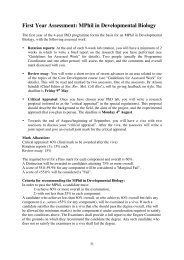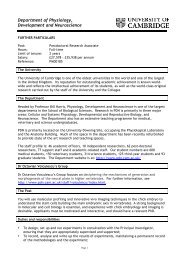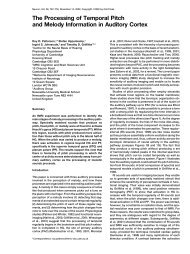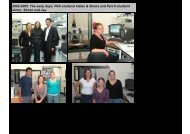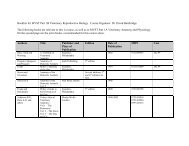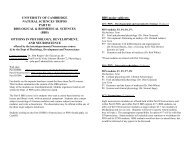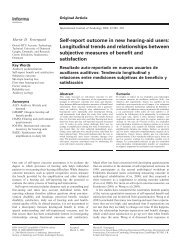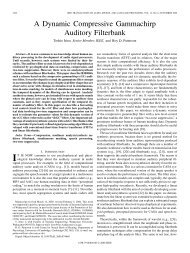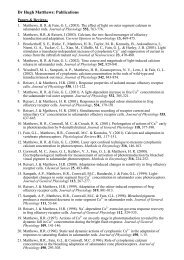part ii physiology, development and neuroscience - Department of ...
part ii physiology, development and neuroscience - Department of ...
part ii physiology, development and neuroscience - Department of ...
You also want an ePaper? Increase the reach of your titles
YUMPU automatically turns print PDFs into web optimized ePapers that Google loves.
Module N7: Local Circuits <strong>and</strong> Neural Networks (N)<br />
Neural networks form the middle ground in approaches to underst<strong>and</strong>ing the nervous system. They<br />
assemble the molecular <strong>and</strong> cellular components needed to process sensory inputs, perform cognitive<br />
functions, <strong>and</strong> pattern motor outputs. Underst<strong>and</strong>ing how cellular <strong>and</strong> synaptic properties influence<br />
nervous system function thus requires insight into the organisation <strong>and</strong> function <strong>of</strong> these networks. This<br />
is currently considered to be the biggest problem facing <strong>neuroscience</strong>.<br />
This module will examine the principles <strong>of</strong> neuronal network function using invertebrate, lower<br />
vertebrate, <strong>and</strong> mammalian model systems. It will outline the requirements that need to be satisfied in<br />
order to claim underst<strong>and</strong>ing <strong>of</strong> a network <strong>and</strong> the extent to which these criteria have been met; highlight<br />
the factors that influence network design; outline how integrated cellular <strong>and</strong> synaptic properties<br />
influence network outputs underlying sensory, motor, <strong>and</strong> cognitive processes; <strong>and</strong> illustrate the<br />
molecular, anatomical, electrophysiological, <strong>and</strong> computational techniques used in network analyses.<br />
The central role <strong>of</strong> networks means that this module can provide general insight that links to modules<br />
that focus on molecular <strong>and</strong> cellular mechanisms (how can these properties influence higher functions),<br />
or on higher-level aspects <strong>of</strong> sensory, motor, or cognitive functions (what cellular mechanisms could<br />
underlie these effects).<br />
This module cannot be taken with Systems <strong>and</strong> Clinical Physiology (P8).<br />
Module organiser: Dr David Parker (djp27@cam.ac.uk)<br />
Module N8: Learning, Memory <strong>and</strong> Cognition (N)<br />
This module (organised by the Dept. <strong>of</strong> Experimental Psychology <strong>and</strong> shared with that Part II) takes a<br />
broad approach to the neural basis <strong>of</strong> learning, memory <strong>and</strong> cognition. The first 15 lectures cover<br />
learning <strong>and</strong> memory, integrating the cellular, systems, <strong>and</strong> psychological levels. Topics covered<br />
include: amnesia in humans <strong>and</strong> animals; theories <strong>of</strong> hippocampal function; computational models <strong>of</strong><br />
memory; mechanisms <strong>of</strong> cellular-level consolidation <strong>and</strong> reconsolidation; the amygdala (emotional<br />
memory); the cerebellum; <strong>and</strong> learning in simple systems such as the invertebrate Aplysia. The<br />
remaining 9 lectures cover higher cognitive functions in humans <strong>and</strong> monkeys. Topics covered include<br />
higher-level visual cognition, semantic memory, cognitive control <strong>of</strong> memory <strong>and</strong> the “executive<br />
functions” <strong>of</strong> the prefrontal cortex.<br />
This module cannot be taken with Genomics <strong>and</strong> the Future <strong>of</strong> Medicine (P7) or as <strong>part</strong> <strong>of</strong> the PDN<br />
Neuroscience theme.<br />
Module organisers: Dr Tim Bussey (tjb1000@cam.ac.uk) <strong>and</strong> Dr Lisa Saksida (lms42@cam.ac.uk)<br />
Module P2: Pluripotency <strong>and</strong> Differentiation: Interactions between Embryonic <strong>and</strong><br />
Extraembryonic tissues (D, P)<br />
The transformation <strong>of</strong> a fertilised egg to a blastocyst encompasses a series <strong>of</strong> fundamental cellular<br />
events that culminate in the divergence <strong>of</strong> the embryonic <strong>and</strong> extra-embryonic cell lineages. During this<br />
process the initial totipotent egg generates first pluripotent cells <strong>of</strong> the morula which progressively<br />
become restricted to different fates, first the differentiation between trophectoderm <strong>and</strong> the pluripotent<br />
inner cell mass, <strong>and</strong> later differentiation <strong>of</strong> the latter into epiblast <strong>and</strong> primitive endoderm. In this module<br />
you will explore how these decisions are made <strong>and</strong> what transcriptional networks <strong>and</strong> epigenetic<br />
modifications reinforce them. You will also consider subsequent interactions between the trophoblast<br />
<strong>and</strong> the maternal tissues that lead to implantation <strong>and</strong> establishment <strong>of</strong> a successful pregnancy.<br />
The module will start by examining the <strong>development</strong> <strong>of</strong> cell polarisation <strong>and</strong> the effects <strong>of</strong> subsequent<br />
symmetrical <strong>and</strong> asymmetrical cell division <strong>and</strong> cell position in creating unique cell populations. The<br />
subsequent differentiation <strong>of</strong> the inner cell mass, the concept <strong>of</strong> embryonic stem cells <strong>and</strong> their<br />
therapeutic potential in regenerative medicine will then be explored, with comparisons being made<br />
between the mouse <strong>and</strong> human.<br />
You will then investigate how the extra-embryonic lineages interact with the maternal tissues to establish<br />
a human pregnancy. This will include consideration <strong>of</strong> endometrial receptivity, implantation,<br />
decidualisation <strong>and</strong> the factors that regulate trophoblast invasion, including interactions with the maternal<br />
14



